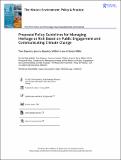Files in this item
Proposed policy guidelines for managing heritage at risk based on public engagement and communicating climate change
Item metadata
| dc.contributor.author | Dawson, Tom | |
| dc.contributor.author | Hambly, Joanna | |
| dc.contributor.author | Lees, William | |
| dc.contributor.author | Miller, Sarah | |
| dc.date.accessioned | 2021-08-25T09:30:06Z | |
| dc.date.available | 2021-08-25T09:30:06Z | |
| dc.date.issued | 2021 | |
| dc.identifier | 275293403 | |
| dc.identifier | 8300da1c-78a8-41dd-9f1b-65b572b3d3f6 | |
| dc.identifier | 000684413500001 | |
| dc.identifier | 85112314190 | |
| dc.identifier.citation | Dawson , T , Hambly , J , Lees , W & Miller , S 2021 , ' Proposed policy guidelines for managing heritage at risk based on public engagement and communicating climate change ' , The Historic Environment: Policy & Practice , vol. 12 , no. 3-4 , pp. 375-394 . https://doi.org/10.1080/17567505.2021.1963573 | en |
| dc.identifier.issn | 1756-7505 | |
| dc.identifier.other | ORCID: /0000-0002-9229-7942/work/99115898 | |
| dc.identifier.other | ORCID: /0000-0001-6428-387X/work/128096933 | |
| dc.identifier.uri | https://hdl.handle.net/10023/23832 | |
| dc.description.abstract | The deterioration and loss of our historic environment due to natural erosive processes, exacerbated by climate change, already outpaces available resources for preservation and will accelerate over the coming century. While this process is divisive and destructive, it is also bringing together international collaborators who are developing more holistic approaches to addressing heritage at risk. In 2018, an intensive fieldtrip and series of workshops as part of the Learning from Loss project brought researchers and practitioners from both sides of the Atlantic together with community stakeholders. Over twelve days, the delegates considered alternative futures for heritage at risk, exploring diverse perspectives and observing action previously taken at threatened sites by both heritage professionals and local communities, often working in collaboration. Recognising that not everything can be saved, the structured discussions and site visits revealed a number of insights into ways that action could be planned in the future. The suggestions also highlighted differences in the way that heritage is managed in the UK and the US. This paper summarises the findings of the field trip and discusses how there may need to be a sea-change in thinking in the United Sates in order to prepare for the growing disaster facing an increasing number of archaeological monuments. | |
| dc.format.extent | 21 | |
| dc.format.extent | 11377153 | |
| dc.language.iso | eng | |
| dc.relation.ispartof | The Historic Environment: Policy & Practice | en |
| dc.subject | Climate change | en |
| dc.subject | Heritage at risk | en |
| dc.subject | Archaeology | en |
| dc.subject | Public archaeology | en |
| dc.subject | CC Archaeology | en |
| dc.subject | GE Environmental Sciences | en |
| dc.subject | NDAS | en |
| dc.subject | SDG 13 - Climate Action | en |
| dc.subject.lcc | CC | en |
| dc.subject.lcc | GE | en |
| dc.title | Proposed policy guidelines for managing heritage at risk based on public engagement and communicating climate change | en |
| dc.type | Journal article | en |
| dc.contributor.institution | University of St Andrews. Scottish Oceans Institute | en |
| dc.contributor.institution | University of St Andrews. School of History | en |
| dc.identifier.doi | 10.1080/17567505.2021.1963573 | |
| dc.description.status | Peer reviewed | en |
This item appears in the following Collection(s)
Items in the St Andrews Research Repository are protected by copyright, with all rights reserved, unless otherwise indicated.

